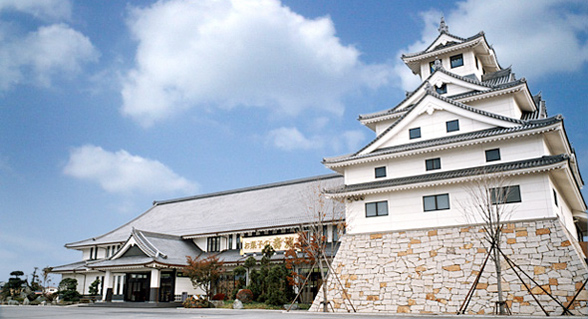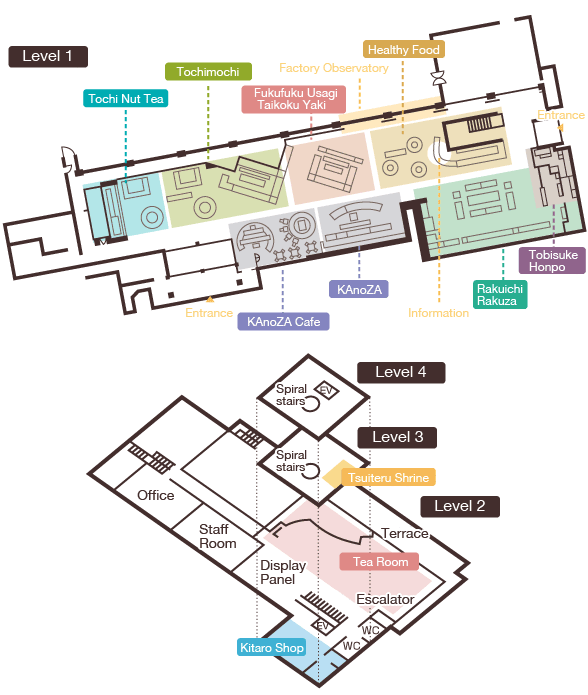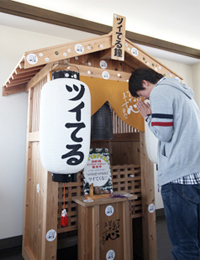Introduction of Kotobuki Castle
Introduction of "Kotobuki Castle"
The castle sits by the Yonago Highway inter-change and welcomes locals and tourists who visit Sanin area. The castle was designed after Yonago Castle, which no longer exists and was completed in 1993.

The 360-degree panoramic view from the observatory floor.


In the castle we have the confectionary shop "Fuku Usagi", seafood shop "Tobisukeya Honpo", a tearoom, a take-out shop, an observatory floor, factory observatory line, and a mini museum to introduce the local history. Stop by Kotobuki Castle between your sightseeing destinations in the area.

Our confectionary theme park, "Kotobuki Castle" was designed after Yonago Castle and it has been 20 years since its completion. The observatory floor is 27m high, the stonewall is 6m high and there are 105cm of fish ornaments on top of the tiled roof.
The observatory floor has a 360-degree panoramic view of Mt. Daisen and the Yumigahama peninsula.
On the observatory floor, there is "Tsuiteru Shrine" with a bell that is said to bring good fortune. Guests are welcome to strike the bell for all the luck they need! Entrance is free of charge.

Kotobuki Castle Construction Details
| Address | 1605-1 Sada, Yodoe-Cho, Yonago, Tottori |
|---|---|
| Property size | 12,699 m2 |
| Total floor size | 4,400 m2 |
| Style | Tiled roof with a main building |
| Steel frame and iron reinforcing bars | 730t |
| Height of the observatory floor | 27m (stone wall 6m, fish ornaments 105cm) |
| Number of roof tiles | 86,480 |
| Completed | April 25, 1993 |
The legend of Yonago Castle and the historic picture scroll
History of Yonago Castle
In 1590, the powerful warlord general Hideyoshi Toyotomi defeated the Late Hōjō clan at the Siege of Odawara, which brought an end to the Warring States era, bringing him great control and unification of the entire nation.
In 1591, Hideyoshi gave the area between Izumo and Houki (where Yonago is today) to a daimyo called, Kikkawa Hiroie who already had Toda Castle as a residence. Kikkawa's castle however was inconveniently located in the mountains, so he decided to build a new castle in Yonago, which was more central in his new territory. Back then, the style of castles had an observatory in the center and were symmetrical in design. Yonago Castle was the first castle of this kind in the Sanin area.
However, in 1592, Hideyoshi launched the first invasion of Korea with the intention to conquer Ming Dynasty China, sending over 150,000 soldiers. Kikkawa, who was preparing for his new castle construction, was ordered by Hideyoshi to join the attacks on Korea. He served in the campaign until 1598 when Hideyoshi finally died, forcing the withdrawal of all troops back to Japan. Kikkawa played a key role in the battles and was greatly appreciated by Hideyoshi.
Upon his return to Japan, Kikkawa restarted his Yonago Castle construction in 1598. Although after losing his political position in the Sekigahara Battle in 1600, the castle was left only 70% complete.
In 1601, Kazutada Nakamura from Sunpu was sent to this unfinished castle in Yonago by the soon to be Shogun, Ieyasu Tokugawa. Despite being only 13 years of age, the new lord and his retainer, Houkinokamikazutada Matsudaira finally completed the castle in 1602, even though the style and design were altered from the original plan.
The Nakamura clan was from Osaka, so their construction of Yonago Castle was inspired by the design of the great Osaka Castle.
But only after a year in the new post, there was turmoil within the clan, as Kazutada Nakamura attempted a murder in a fight for leadership. At around the same time, Ieyasu Tokugawa received the title of shogun and started the Tokugawa shogunate, the start of the Edo period in 1603.
In 1609, Kazutada Nakamura died unexpectedly at the age of 20, marking the end of the Nakamura clan. A year later, Sadayasu Kato was appointed lord of the castle until his relocation in 1617. The Ikeda clan then ruled until 1632 when control of the castle was handed down to their retainer, Arao Naritoshi. For over 230 years the Arao family ruled the castle until the Meiji Restoration in 1868, when it was declared that all domains were to be returned to the Emperor.
There were no offers to buy the castle when remaining descendants of samurai gave up volunteering on its maintenance. In 1881, a local shop bought the castle for only 37 yen, only to use its timber for firewood. Lasting only 279 years in its completed form, sadly all that has remained of the castle now are stone ruins on the hilltop of central Yonago.
Style of Yonago Castle
Yonago Castle had a main tower and a 4-story watchtower. The main tower was located in the north side, and although the size of it was not too large, being built on top of a hill that is 90m high, made it look much bigger than its actual size. The outer building was categorized as an eight-ridge structure. The top level had two floors inside, but there was no partition outside. The style was unique, in that it was as if the builders simplified the original design.





